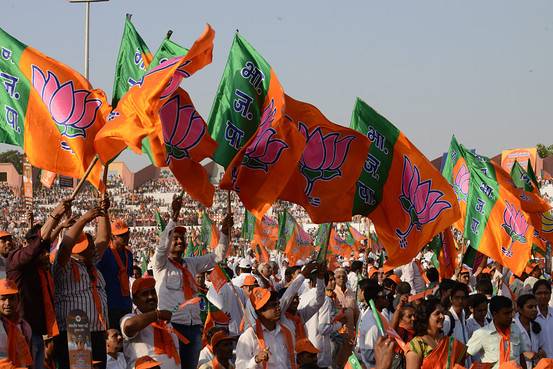This article attempts to examine the socio-economic polices of the BJP (Bhartiya Janata Party) government in India. More than two years have passed since BJP came to power in India under the leadership of Mr. Modi. I think it would be interesting to analyse its economic policies. The BJP is the political front of the RSS (Rastriya Sevak Sangh) and most of the BJP leaders including the Prime Minister Mr. Modi have been members of the RSS. Both organisations are fully committed to the ideology of Hindutva, which is deep rooted in hate against religious minorities, particularly Muslims and Christians.
It is important to study India’s development because of its huge population, market-size and multi-religious, and diverse communities, which would have global impact.
Since BJP came to power in May 2014, its ministers and senior party leaders have been coming out in support of Hindu Rastra (Hindu nation). They have stepped up campaign to the protection of cows and against inter-marriage with Muslims. Since Modi became Prime Minister the religious minorities are feeling more insecure and vulnerable. Even government ministers and members of parliament have openly airing communal sentiments and hate speeches and inciting violence against minorities. The BJP leaders continue to spread false information about Muslims. They are also threatening to launch a ghar-wapsi (return home) programme, i.e. enforced conversion of religious minorities back to Hinduism. As London based magazine The Economist (2015:71) commented: “The BJP’s election victory last year was attributed to its promise of competence and good governance. It persuaded enough voters that the Hindu-nationalist part of its agenda and the shadow over […] past allegations of his [Modi’s] complicity in anti-Muslim violence in the State of Gujarat in 2002 were marginal. Now many worry that Hindu nationalism is a pillar of Mr Modi’s vision, after all”.
It is important to analyse briefly the RSS because the organisation is too politically significant to be ignored and since its political wing has come to power i.e. the BJP attacks against Muslims have risen sharply. Cultural issues such as cow slaughter and the building of a Ram temple at Ayodhya have been raised again by the RSS as a means of dividing communities and keeping Muslims in a state of constant fear and insecurity. The RSS/BJP also claims that mosques at Kashi (also known as Varanasi) and Mathura are disputed places of worship.
However, I will focus here on the economic policies of the Modi government in India. With the collapse of Soviet Union, the Indian ruling elites also looked for closer integration with the global capitalism. IMF loan was sought in 1991 and in return India was asked to make changes in economic policy and the economy was opened, imports were liberalised and taxes on capital were reduced. As a result, the GDP growth in 1991 to 2010 increased to 5% annually, which shows no significant increase over that of 1980s. More disturbing is that since 1997, the agriculture and manufacturing sector, which accounts for more than four-fifths of the India’s workforce have only grown 2.3% and 4.5% respectively, compared to 11.5% increase in the financial services per year. Since early 1990s there was no expansion of area under irrigation. The government has slashed subsidies and extension services to rural sector have been weakened.
The government priority has changed from self-sufficiency in food production and consumption to production for export. The contribution of agriculture and allied sector to GDP has been steadily declining, which is around 14% in 2016 and the growth of the agriculture sector is lower than other sectors. Moreover, the policy of financial liberalisation means less institutional credits available to farmers and put them at the mercy of private money lenders. As a result, numbers of farmer suicides have risen dramatically in the recent years. Neoliberalism is perceived to follow specific economic policies that may not be in the interest of majority of the Indian people, but in the interest of finance capital.
In 2008 on the advent of global financial crisis, a number of measures including the provisions of loan on housing and consumer goods to boost middle class demand were adopted and it did help to restore growth temporarily. But it has its own limitations with risking credit bubbles and balance of payments difficulties given the high import content of the middle class consumption.
It seems that after the economic liberalisation the GDP growth is largely limited to service sector and it has been riding on credit bubble. The economic growth has not made the manufacturing or export sector robust. Unlike in other high growth economies such as China, where manufacturing sector witnessed dramatic change in terms of rise in employment, productivity and exports, while in India the manufacturing sector has not experienced any rapid transformation. Nor the economic liberalisation has delivered any benefit to those who steeped in poverty and deprivation.
I find that on the name of economic reforms Modi’s government strategy seems to be to cut subsidies, increase regressive taxes, also increase capital expenditures and privatise public sector banks and state owned enterprises such as Indian Railways. To undertake capital expenditure projects like setting up to smart cities will not be able to generate long term economic growth. All these measures would certainly accelerate the process of handing out the Indian economy over to the big corporations, who have financed and supported to bring him to power.
In short, neoliberal policies to deliver economic growth have already been exhausted. Providing further dose by the current BJP government will hardly provide any new impetus. The process of uneven development and deepening socio-economic crisis has created conditions of backwardness and poverty, and the failure of the Congress government in the past to implement progressive reforms, which in turn had created an opportunity for right wing Hindu organisations to organise people on the basis of religion.






